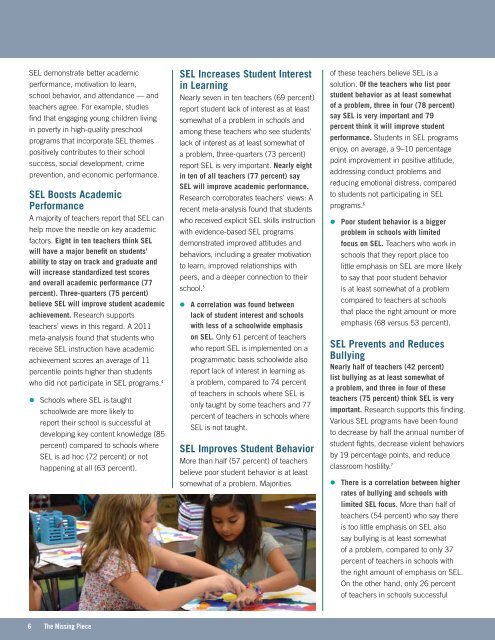CASEL-Report-low-res-FINAL
CASEL-Report-low-res-FINAL
CASEL-Report-low-res-FINAL
Create successful ePaper yourself
Turn your PDF publications into a flip-book with our unique Google optimized e-Paper software.
SEL demonstrate better academic<br />
performance, motivation to learn,<br />
school behavior, and attendance — and<br />
teachers agree. For example, studies<br />
find that engaging young children living<br />
in poverty in high-quality p<strong>res</strong>chool<br />
programs that incorporate SEL themes<br />
positively contributes to their school<br />
success, social development, crime<br />
prevention, and economic performance.<br />
SEL boosts Academic<br />
Performance<br />
A majority of teachers report that SEL can<br />
help move the needle on key academic<br />
factors. Eight in ten teachers think SEL<br />
will have a major benefit on students’<br />
ability to stay on track and graduate and<br />
will increase standardized test sco<strong>res</strong><br />
and overall academic performance (77<br />
percent). Three-quarters (75 percent)<br />
believe SEL will improve student academic<br />
achievement. Research supports<br />
teachers’ views in this regard. A 2011<br />
meta-analysis found that students who<br />
receive SEL instruction have academic<br />
achievement sco<strong>res</strong> an average of 11<br />
percentile points higher than students<br />
who did not participate in SEL programs. 4<br />
z Schools where SEL is taught<br />
schoolwide are more likely to<br />
report their school is successful at<br />
developing key content knowledge (85<br />
percent) compared to schools where<br />
SEL is ad hoc (72 percent) or not<br />
happening at all (63 percent).<br />
6 the Missing Piece<br />
SEL increases Student inte<strong>res</strong>t<br />
in Learning<br />
Nearly seven in ten teachers (69 percent)<br />
report student lack of inte<strong>res</strong>t as at least<br />
somewhat of a problem in schools and<br />
among these teachers who see students’<br />
lack of inte<strong>res</strong>t as at least somewhat of<br />
a problem, three-quarters (73 percent)<br />
report SEL is very important. Nearly eight<br />
in ten of all teachers (77 percent) say<br />
SEL will improve academic performance.<br />
Research corroborates teachers’ views: A<br />
recent meta-analysis found that students<br />
who received explicit SEL skills instruction<br />
with evidence-based SEL programs<br />
demonstrated improved attitudes and<br />
behaviors, including a greater motivation<br />
to learn, improved relationships with<br />
peers, and a deeper connection to their<br />
school. 5<br />
z A correlation was found between<br />
lack of student inte<strong>res</strong>t and schools<br />
with less of a schoolwide emphasis<br />
on SEL. Only 61 percent of teachers<br />
who report SEL is implemented on a<br />
programmatic basis schoolwide also<br />
report lack of inte<strong>res</strong>t in learning as<br />
a problem, compared to 74 percent<br />
of teachers in schools where SEL is<br />
only taught by some teachers and 77<br />
percent of teachers in schools where<br />
SEL is not taught.<br />
SEL improves Student behavior<br />
More than half (57 percent) of teachers<br />
believe poor student behavior is at least<br />
somewhat of a problem. Majorities<br />
of these teachers believe SEL is a<br />
solution. of the teachers who list poor<br />
student behavior as at least somewhat<br />
of a problem, three in four (78 percent)<br />
say SEL is very important and 79<br />
percent think it will improve student<br />
performance. Students in SEL programs<br />
enjoy, on average, a 9–10 percentage<br />
point improvement in positive attitude,<br />
add<strong>res</strong>sing conduct problems and<br />
reducing emotional dist<strong>res</strong>s, compared<br />
to students not participating in SEL<br />
programs. 6<br />
z Poor student behavior is a bigger<br />
problem in schools with limited<br />
focus on SEL. Teachers who work in<br />
schools that they report place too<br />
little emphasis on SEL are more likely<br />
to say that poor student behavior<br />
is at least somewhat of a problem<br />
compared to teachers at schools<br />
that place the right amount or more<br />
emphasis (68 versus 53 percent).<br />
SEL Prevents and Reduces<br />
bullying<br />
Nearly half of teachers (42 percent)<br />
list bullying as at least somewhat of<br />
a problem, and three in four of these<br />
teachers (75 percent) think SEL is very<br />
important. Research supports this finding.<br />
Various SEL programs have been found<br />
to decrease by half the annual number of<br />
student fights, decrease violent behaviors<br />
by 19 percentage points, and reduce<br />
classroom hostility. 7<br />
z There is a correlation between higher<br />
rates of bullying and schools with<br />
limited SEL focus. More than half of<br />
teachers (54 percent) who say there<br />
is too little emphasis on SEL also<br />
say bullying is at least somewhat<br />
of a problem, compared to only 37<br />
percent of teachers in schools with<br />
the right amount of emphasis on SEL.<br />
On the other hand, only 26 percent<br />
of teachers in schools successful


